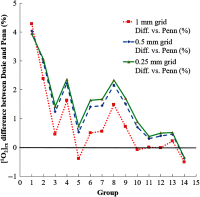Validation of combined Monte Carlo and photokinetic simulations for the outcome correlation analysis of benzoporphyrin derivative-mediated photodynamic therapy on mice
- PMID: 30873764
- PMCID: PMC6416474
- DOI: 10.1117/1.JBO.24.3.035006
Validation of combined Monte Carlo and photokinetic simulations for the outcome correlation analysis of benzoporphyrin derivative-mediated photodynamic therapy on mice
Abstract
We compare previously reported benzoporphyrin derivative (BPD)-mediated photodynamic therapy (PDT) results for reactive singlet oxygen concentration (also called singlet oxygen dose) on mice with simulations using a computational device, Dosie™, that calculates light transport and photokinetics for PDT in near real-time. The two sets of results are consistent and validate the use of the device in PDT treatment planning to predict BPD-mediated PDT outcomes in mice animal studies based on singlet oxygen dose, which showed a much better correlation with the cure index than the conventional light dose.
Keywords: medical device; photodynamic therapy; solid cancer therapy.
Figures








Similar articles
-
Reactive oxygen species explicit dosimetry to predict tumor growth for benzoporphyrin derivative-mediated vascular photodynamic therapy.J Biomed Opt. 2020 Jan;25(6):1-13. doi: 10.1117/1.JBO.25.6.063805. J Biomed Opt. 2020. PMID: 31912689 Free PMC article.
-
Evaluation of singlet oxygen explicit dosimetry for predicting treatment outcomes of benzoporphyrin derivative monoacid ring A-mediated photodynamic therapy.J Biomed Opt. 2017 Feb 1;22(2):28002. doi: 10.1117/1.JBO.22.2.028002. J Biomed Opt. 2017. PMID: 28301655 Free PMC article.
-
Calculation of singlet oxygen dose using explicit and implicit dose metrics during benzoporphyrin derivative monoacid ring A (BPD-MA)-PDT in vitro and correlation with MLL cell survival.Photochem Photobiol. 2011 Sep-Oct;87(5):1129-37. doi: 10.1111/j.1751-1097.2011.00942.x. Epub 2011 Jul 7. Photochem Photobiol. 2011. PMID: 21575000
-
Quinones as photosensitizer for photodynamic therapy: ROS generation, mechanism and detection methods.Photodiagnosis Photodyn Ther. 2016 Mar;13:175-187. doi: 10.1016/j.pdpdt.2015.07.177. Epub 2015 Aug 1. Photodiagnosis Photodyn Ther. 2016. PMID: 26241780 Review.
-
Two-photon photodynamic therapy by water-soluble self-assembled conjugated porphyrins.Biomed Res Int. 2013;2013:125658. doi: 10.1155/2013/125658. Epub 2012 Dec 27. Biomed Res Int. 2013. PMID: 23484074 Free PMC article. Review.
Cited by
-
Photosensitizer spatial heterogeneity and its impact on personalized interstitial photodynamic therapy treatment planning.J Biomed Opt. 2025 Jan;30(1):018001. doi: 10.1117/1.JBO.30.1.018001. Epub 2025 Jan 11. J Biomed Opt. 2025. PMID: 39802351 Free PMC article.
-
FullMonteCUDA: a fast, flexible, and accurate GPU-accelerated Monte Carlo simulator for light propagation in turbid media.Biomed Opt Express. 2019 Aug 21;10(9):4711-4726. doi: 10.1364/BOE.10.004711. eCollection 2019 Sep 1. Biomed Opt Express. 2019. PMID: 31565520 Free PMC article.
-
Integrating clinical access limitations into iPDT treatment planning with PDT-SPACE.Biomed Opt Express. 2023 Jan 9;14(2):714-738. doi: 10.1364/BOE.478217. eCollection 2023 Feb 1. Biomed Opt Express. 2023. PMID: 36874501 Free PMC article.
-
Photodynamic therapy in a pleural cavity using monte carlo simulations with 2D/3D Graphical Visualization.Glob J Cancer Ther. 2022;8(1):34-35. doi: 10.17352/2581-5407.000045. Epub 2022 Sep 29. Glob J Cancer Ther. 2022. PMID: 37337581 Free PMC article. No abstract available.
-
Computational Optimization of Irradiance and Fluence for Interstitial Photodynamic Therapy Treatment of Patients with Malignant Central Airway Obstruction.Cancers (Basel). 2023 May 6;15(9):2636. doi: 10.3390/cancers15092636. Cancers (Basel). 2023. PMID: 37174102 Free PMC article.
References
Publication types
MeSH terms
Substances
Grants and funding
LinkOut - more resources
Full Text Sources
Other Literature Sources

